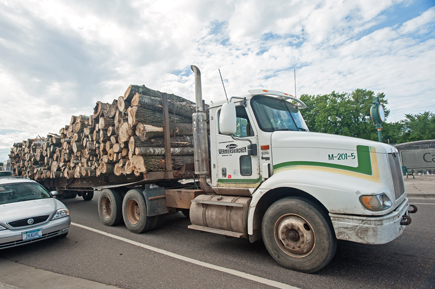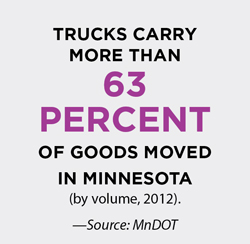Weigh-in-motion (WIM) systems are widely used by state agencies to collect traffic data on major roadways and bridges. In Minnesota, 20 WIM stations gather data about truck volume, class, speed, and weight. WIM sensors, however, are sensitive to factors such as the weather and surrounding road surface conditions, making periodic calibration essential to ensure the accuracy and reliability of the measurements.
To improve the efficiency of WIM calibration, University of Minnesota researchers developed a systematic methodology to detect WIM sensor bias. The MnDOT-funded project was led by Chen-Fu Liao, senior systems engineer in the Department of Civil, Environmental, and Geo- Engineering (CEGE), and CEGE professor Gary Davis.
MnDOT calibrates its WIM sensors twice a year, says Indrajit Chatterjee, a research assistant on the team. (Chatterjee is the recipient of this year’s Matthew Huber Award for Excellence in Transportation Research and Education from CTS.) MnDOT’s current procedures allow it to identify when a WIM system goes out of calibration, but only on a monthly basis; as a result, the reliability of WIM data is frequently questionable.
“With the software developed in this project, we now can see when there are calibration issues much quicker,” says Ben Timerson, transportation data and analysis program manager at MnDOT.
The goal of the research was to develop a statistical quality-control technique that identifies exactly when a system goes out of calibration. “This would allow operators to estimate the bias in the WIM sensor and modify the measurements so that the data are valid year-round and usable for analysis,” Chatterjee explains. “It could also help agencies decide when to schedule onsite testing.”
After developing the algorithm, the researchers tested it using a case study in St. Louis County, Minnesota. Results suggest that the methodology is able to estimate shift in the WIM sensor accurately and indicate when the system goes out of calibration, Chatterjee says.
The team also developed a data analysis software tool—WIM Data Analyst—with an embedded online help document.
“WIM data are used to support traffic load forecasting, pavement design and analysis, infrastructure investment decision making, and transportation planning,” says Liao. “This tool will help agencies get the high-quality data they need without increasing onsite visits, saving time and resources.”
“We are looking to implement this software in the next few months,” says Timerson. “The software will provide a needed solution to improving our data quality and improve the usefulness of WIM data for transportation agencies.”





